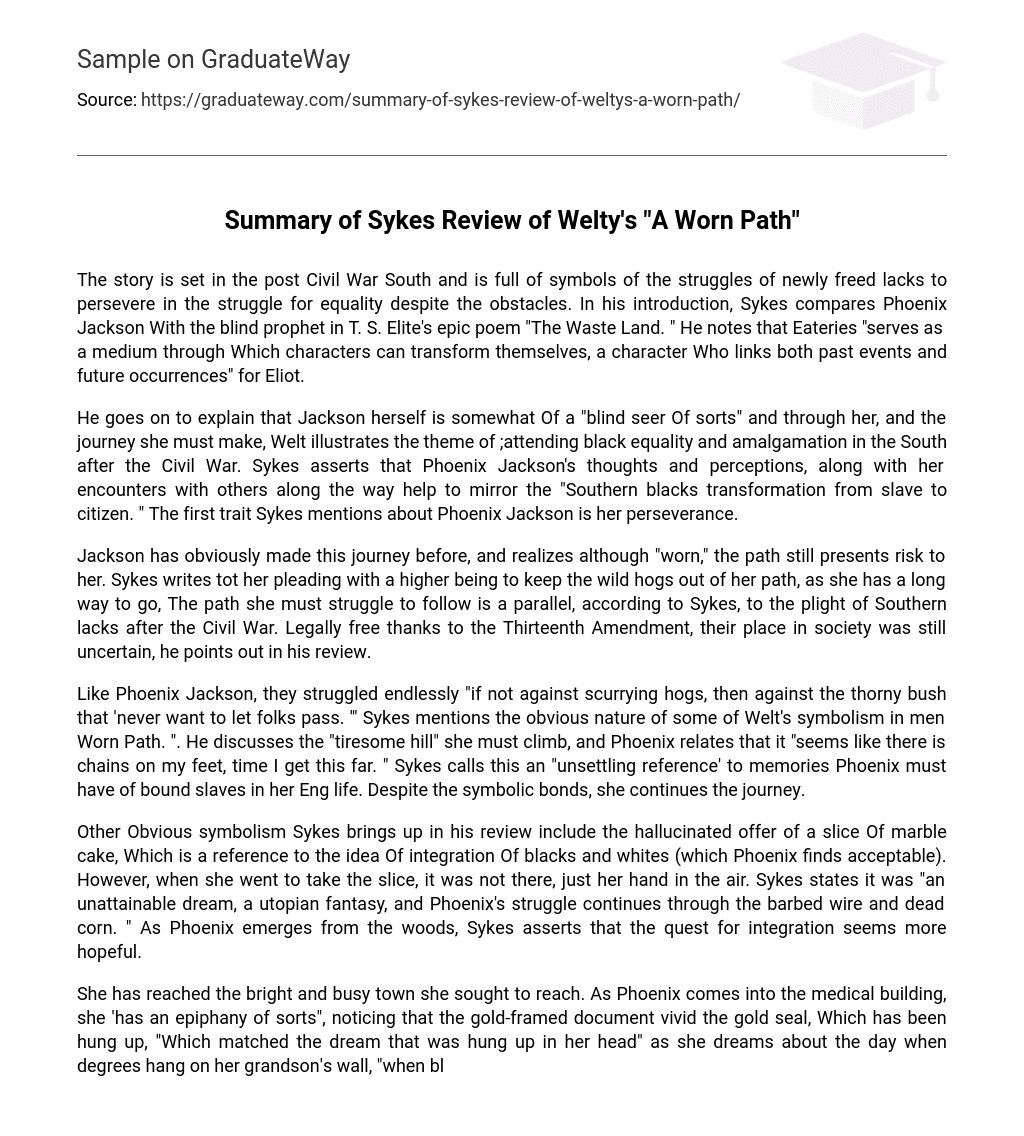The story is set in the post Civil War South and is full of symbols of the struggles of newly freed lacks to persevere in the struggle for equality despite the obstacles. In his introduction, Sykes compares Phoenix Jackson With the blind prophet in T. S. Elite’s epic poem “The Waste Land. ” He notes that Eateries “serves as a medium through Which characters can transform themselves, a character Who links both past events and future occurrences” for Eliot.
He goes on to explain that Jackson herself is somewhat Of a “blind seer Of sorts” and through her, and the journey she must make, Welt illustrates the theme of ;attending black equality and amalgamation in the South after the Civil War. Sykes asserts that Phoenix Jackson’s thoughts and perceptions, along with her encounters with others along the way help to mirror the “Southern blacks transformation from slave to citizen. ” The first trait Sykes mentions about Phoenix Jackson is her perseverance.
Jackson has obviously made this journey before, and realizes although “worn,” the path still presents risk to her. Sykes writes tot her pleading with a higher being to keep the wild hogs out of her path, as she has a long way to go, The path she must struggle to follow is a parallel, according to Sykes, to the plight of Southern lacks after the Civil War. Legally free thanks to the Thirteenth Amendment, their place in society was still uncertain, he points out in his review.
Like Phoenix Jackson, they struggled endlessly “if not against scurrying hogs, then against the thorny bush that ‘never want to let folks pass. ‘” Sykes mentions the obvious nature of some of Welt’s symbolism in men Worn Path. “. He discusses the “tiresome hill” she must climb, and Phoenix relates that it “seems like there is chains on my feet, time I get this far. ” Sykes calls this an “unsettling reference’ to memories Phoenix must have of bound slaves in her Eng life. Despite the symbolic bonds, she continues the journey.
Other Obvious symbolism Sykes brings up in his review include the hallucinated offer of a slice Of marble cake, Which is a reference to the idea Of integration Of blacks and whites (which Phoenix finds acceptable). However, when she went to take the slice, it was not there, just her hand in the air. Sykes states it was “an unattainable dream, a utopian fantasy, and Phoenix’s struggle continues through the barbed wire and dead corn. ” As Phoenix emerges from the woods, Sykes asserts that the quest for integration seems more hopeful.
She has reached the bright and busy town she sought to reach. As Phoenix comes into the medical building, she ‘has an epiphany of sorts”, noticing that the gold-framed document vivid the gold seal, Which has been hung up, “Which matched the dream that was hung up in her head” as she dreams about the day when degrees hang on her grandson’s wall, “when blacks can go to college. ” As she leaves the medical building With ten cents in her pocket, she promises to buy her grandson “a little windmill they sells, made out of paper.
He going to find it hard to believe there is such a thing in the roll. ” Sykes submits this is Welt’s creation of a modern day Don Quixote, painting the picture of her grandson sparring with the windmills that will be ‘his quest for freedom, for equality in this new world that has been opened up for him. ” Sykes presents the characters that Phoenix Jackson encounters along the way as representations tooth attitudes tot Southern whites after the Civil War. The first character of note in Sykes’ review is the white hunter, who runs off a black dog.
Sykes asserts that Welt uses the symbol of the white hunter scaring off the lack dog ‘to show the strength of Phoenix’s dignity, When the hunter further tries to scare off Phoenix, she doesn’t flinch, instead, telling him she is not afraid, and she is determined to reach her destination. Sykes’ analysis of this scene shows Phoenix realizing the reason for her trip is far more important than any risk to her. He writes: “The incident faith the hunter symbolizes the resiliency of the black movement toward equality. ” The conclusion of Sykes review discusses how the attendant in the medical building dismisses Phoenix as a charity case.





